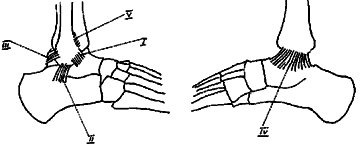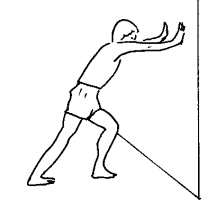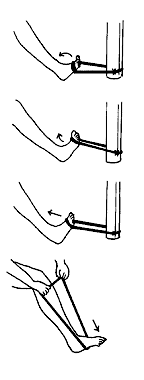
|
|||||||
Ankle Sprain
The lateral ligaments of the ankle consist of the anterior talo-fibular ligament, the calcaneo-fibular ligament, and the posterior talo-fibular ligament.
The medial ligament of the ankle is a broad fan-shaped ligament called the Deltoid ligament.
The ligaments that hold the lower ends of the tibia and fibula together
are called the inferior tibio-fibular syndesmosis. 
Figure: I) Anterior talo-fibular ligament II) Calcaneo-fibular ligament III) Posterior talo-fibular ligament IV) Deltoid ligament V) Syndesmotic ligament
The foot tends to be twisted inwards (inversion injury) more commonly than outwards (eversion injury), due to the anatomical configuration of the ankle and subtalar joints.. As a result, the lateral ligaments of the ankle are much more commonly involved than the medial ligaments. Only in the more severe sprains would the inferior tibio-fibular syndesmosis be involved.
Ankle sprains can be graded according to their severity. A Grade I sprain consists of only mild partial tear of any one of the ligaments of the ankle. A Grade II sprain consists of a partial tear of any of the ligaments, but more extensively. A Grade III sprain consists of a complete tear of any of the ligaments of the ankle, and may be associated with instability of the ankle.
X-rays should be taken in cases of the more serious sprains to rule out any associated fractures.
Grade I sprains are usually treated with immobilization in an ankle wrap or brace for 3 weeks to relieve pain as well as to encourage rest. Ice and elevation are also important for the first 48 hours. Weight-bearing is usually possible without much pain.
Grade II sprains are usually treated like Grade I sprains, but usually requires longer immobilization, even in a cast if necessary from 3 to 6 weeks. Crutch walking may be needed for 2 to 3 weeks.
Grade III sprains are serious injuries. An ankle brace, casting or even surgery may be required, depending on the instability of the ankle and the degree of syndesmotic injury.
After 3 to 6 weeks of treatment, regardless of the severity of ankle sprain, ankle exercises are essential for safe return to sports activities and to minimize the risk of future injury. In the more severe cases, formal physical therapy may be required. In all cases, a home exercise program such as that described below is essential before returning to sports.
If you do not have a cast, you should soak your foot and ankle in warm water and move your foot and ankle in the water for 20 minutes two to three times a day as soon as pain allows you, which is usually 3 days after the injury. Move your foot downwards (plantarflexion), upwards (dorsiflexion), inwards (inversion) and outwards (eversion) to prevent stiffness, and to keep the muscles working.

Stretching exercises for the heel cord should be started as soon as pain allows. Stand about 18 inches away from the wall, and push against it as shown in the illustration right. The heel cord to be stretched is the leg that is further from the wall. The knee is kept straight and the heel should stay on the floor as you push your weight against the wall.

After 3 weeks, you should start on exercises with resistance as illustrated left. Use a surgical tubing from a medical supply house or an elastic belt or bicycle inner tube from the hardware store. Work your ankle against resistance as shown below, making sure all four groups of muscles are exercised. Pull up and outwards, up and inwards, straight up and push straight down against resistance, holding to a count of 5 seconds. Do sets of 10, three times a day.

After your have regained most of the strength in your ankle, you should attempt standing on the injured leg, and then raise yourself on your toes, holding yourself in that position for a count of 5 seconds. As you gain proficiency, practice doing it with your eyes closed to train your sense of balance.
When you can perform all the above exercises with no difficulty, you can begin jogging, then running, then figure-eights and other sports manouvers. When you can do these proficiently, you are ready to return to sports!
NOTICE: The information presented is for your information only, and not a substitute for the medical advice of a qualified physician. Neither the author nor the publisher will be responsible for any harm or injury resulting from interpretations of the materials in this article.
Questions
or comments? Post your thoughts in the Orthoseek
Message Forum!
Find a pediatric orthopedic surgeon
in an area near you.
Home | About Us | Orthopaedic Topics | Message Forum
![]()
Comments, questions, or suggestions are welcome. Please
contact us using this form.